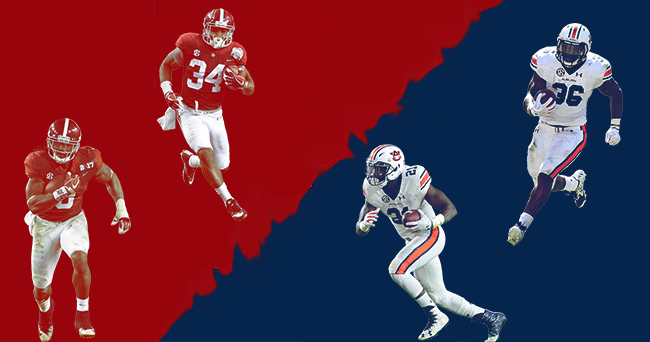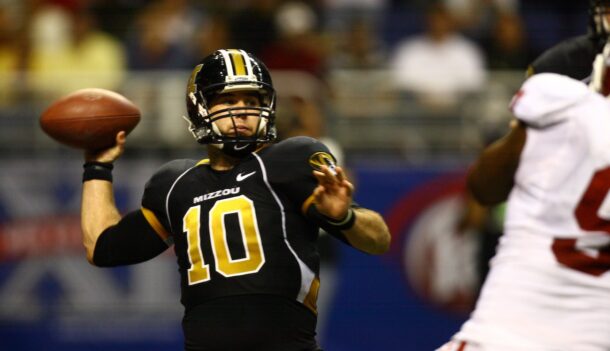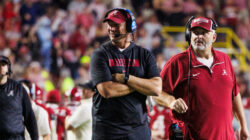
Alabama RBs vs. Auburn RBs: Which group will be better in 2017?
By Clint Lamb
Published:
There has been a running Alabama-Auburn debate over which program has the better ground game seemingly since the first Iron Bowl was played in 1964. With both teams sporting best-in-the-nation potential in their backfields, we make a case for why each might outdo the other in 2017.
The Argument for Alabama
The biggest thing that Alabama has working in its favor is the return of their top five rushers from the 2016 season.
The group is led by junior RB Damien Harris, who ran for 1,037 yards this past season. Despite his success between the 20-yard lines, Harris struggled to make an impact in the red zone — he rushed for only two touchdowns. His lack of production is a direct result of Bo Scarbrough — who ran for 812 yards and 11 touchdowns — receiving a bulk of the carries on the goal line.
Alabama’s two main running backs from 2016 were an underrated duo. Harris averaged 7.1 yards per carry — the highest YPC number ever under Nick Saban — and Scarbrough was nearly as good at 6.5. The 2016 season didn’t allow any Alabama running back to dominate the carries like Derrick Henry did in 2015, but the unit remained effective.
When talking about Alabama running backs, it’s hard to forget about rising sophomore Josh Jacobs. The former 3-star prospect was a surprising contributor last season. He finished with the most receiving yards of any running back on the roster — 156 for an impressive 11.1 yards per catch. As a runner, he showed glimpses of former Heisman Trophy RB Mark Ingram, but he was a lot more effective as a receiver.
It’s mind-blowing to think about the talent that Alabama was already returning at running back, but the Tide also added two premium players at the position during the 2017 recruiting cycle. According to 247Sports, Najee Harris was the No. 2 ranked running back while Tuscaloosa native Brian Robinson checked in at No. 8. When looking at Harris in particular, it’s easy to see why he was so highly recruited. He’s a generational talent who can make an impact as both a runner and a receiver.
It’s tough to rival Alabama’s group at running back, but Auburn has a chance.
The Argument for Auburn
During the 2016 season, Auburn fielded one of the top thunder and lightning duos in not only the SEC, but in all of college football.
Converted fullback Kamryn Pettway was well on his way to a run at the Heisman before leg injuries sidelined him for four games. Still, the 6-foot, 240-pound back rushed for 1,224 yards and seven touchdowns in nine games. He was forced to sit out during the spring as a result of another injury, but he should be a full-go by fall camp.
The other dynamite running back on the Plains is none other than Kerryon Johnson from Madison, Ala. Johnson doesn’t bring the size that Pettway does — he’s listed at 6-foot, 211 pounds — but he is an effective runner and receiver. He makes defenders miss, and he has steadily gotten better since arriving on campus before the 2015 season.
The argument could be made that Auburn hasn’t fielded this strong of a 1-2 punch at running back since the days of Cadillac Williams and Ronnie Brown. Pettway checked in as the SEC’s fourth-ranked rusher among running backs, while Johnson checked in at No. 11 on the list. The only issue that could be facing the Tigers backfield is health. In addition to the injuries that have sidelined Pettway, Johnson re-aggravated an ankle injury during last Saturday’s spring game.
The Nod
This was a tough decision, but the nod has to go to Alabama due to depth. Auburn’s top two can compete with any team in the SEC — and maybe the country — but Alabama could end up having the deepest stable of running backs in college football history.
Now, this article was geared strictly towards the running backs, but both team’s have quarterbacks who can rack up yards in the run game as well. If we were to include the rushing ability of both Jalen Hurts and Jarrett Stidham — assuming he continues to be Auburn’s starting quarterback — then the gap would widen even further in Alabama’s favor.
Stidham is underrated as a runner, but Hurts is one of college football’s premier dual-threat quarterbacks. He finished last season with 954 rushing yards — landing him at No. 12 among top rushers in the SEC — and 13 touchdowns. As he develops as a passer, those numbers might decline somewhat, but he is still an elite threat with the ball in his hands.
Overall, both teams should produce rushing attacks that can take over football games in 2017.
Clint helps cover the SEC West for Saturday Down South. His work can also be found on USA TODAY Sports, The 'Bama Beat podcast and The Bullpen with TonyMac and The Lamb. Previous stops include SEC Country, 247Sports and Touchdown Alabama Magazine.







